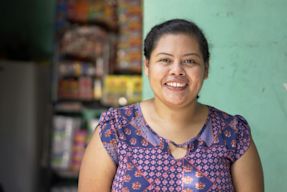Consider this: A woman in sub-Saharan Africa is more likely than a man to start her own business — and yet women entrepreneurs in the region have six times less capital than male entrepreneurs. Today, women and the businesses they run — in Africa and around the world — are bearing the brunt of the COVID-19 pandemic’s economic fallout. This threatens to derail the world’s progress towards both the Sustainable Development Goals and the gender equality agenda set forth 25 years ago at the World Conference on Women in Beijing.
Kiva is committed to expanding women’s financial inclusion because we believe that women — the hair salon owner in Manila, the shopkeeper in Accra, the coffee farmer in the Nicaraguan countryside — are at the heart of efforts to build more inclusive, prosperous, and equitable communities. More than 80% of Kiva loans go to women — over $1 billion to nearly 3 million women around the world since 2005.
But we know that microloans alone are not enough to overcome the numerous barriers that prevent women from growing their businesses and exercising their agency. We need to work with our community of lending and strategic partners to reach women who are financially excluded with the right kind of capital in the right kind of way.
One way we are doing this is by collaborating with non-traditional lending partners to build innovative financing and credit programs that recognize women’s distinct needs. Thanks to a five-year partnership with Mastercard Foundation, we have seen this innovation take root in countries across Africa and learned many lessons.
What we have learned is that financial service providers (FSPs) often have less incentive to engage and serve women because of higher upfront investment and uncertain returns. Organizations that work to empower women, on the other hand, usually don’t have the expertise to develop lending programs.
Kiva’s flexible, risk-tolerant capital, technical assistance, and other capacity-building support allows both these groups to experiment, build new initiatives, and learn from them. Here are four key takeaways that are shaping our collective efforts to evolve gender-smart investing and microfinance:
Make microcredit part of holistic women’s empowerment programs that include peer support and mentoring, business and life skills training, and subsidized financing.
For example, we work with the Campaign for Female Education (Camfed) to develop a program that offers young women in Malawi, Zambia, and Ghana 0% interest loans and business training to start and grow their own businesses. The program has successfully promoted young women’s self-reliance and helped them to resist pressure to marry early.
Move beyond solidarity loans to create a credit ladder for underserved women.
Solidarity loans are well established in addressing the lack of collateral that hinders womens’ access to credit. But women’s repayment of these group loans should enable them to then obtain individual loans. Kiva is partnering with Urwego Bank in Rwanda to test one such credit ladder for women and learn how it expands their access to capital.
Use innovative financing to expand access to products and services that reduce women’s time poverty.
Worldwide, women’s household responsibilities continue to deprive them of the time and energy they need to pursue economic opportunities. One recent study estimates that in some countries, women lose 5 hours per day to collecting fuelwood and cooking. Kiva has sought to tackle this problem by helping social enterprises such as African Clean Energy (ACE) to create credit programs that enable women in rural, low-income communities to get efficient, modern cookstoves.
Invest in digitization to help FSPs reach financially excluded women.
Our partners often request technical assistance around digitizing their operations and adopting mobile technology to enhance services for all their clients. This could also be a powerful strategy for advancing women’s financial inclusion, offering them the privacy and autonomy they need to control their finances. But these services need to take into account women’s access to technology and how they can be put at risk by it. Creating digital services tailored for women is one area we seek to explore further with partners.
These are some of the financial innovations that we have seen work for excluded women. We are leveraging these learnings to now work with our community of lending partners to expand their reach across new countries and regions.
Additionally, as part of a recent partnership with USAID to design the Invest in Women Fund, we will hold a listening tour to learn from potential investors and investees how we might bring them together to unlock $100 million for women entrepreneurs and scale global investment in women.
If you’d like to learn more, share your ideas, or join us on this journey, feel free to reach out to us at partnerships@kiva.org.














